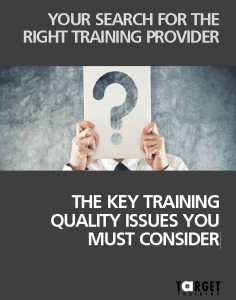The best training course I have ever been on (or why wanting to be there made all the difference)
Most of my working life I have worked independently in or with small organisations, where training has often been on the job and learning by doing (the “70%”), or learning from and copying colleagues (the “20%”) And to be clear I’m not complaining –I’ve worked with and learnt from a long list of inspiring individuals. So a big thank you to Jörg, Wilfried, Wolfgang, George, Danny, Richard, Mac, Piers, Niven and many many others. Indeed the best “training” I have ever experienced was the 20% of the 70/20/10 model – and the best training course I have ever been on was one I really wanted to join. Here’s what made it such a great experience.
Professional and personal benefit
I’ve never been “sent to training.” Any seminar I’ve attended has been self-financed, and I’ve therefore always been choosy. Earlier in my career I attended seminars that could provide a hard benefit for my own work – but the best seminar I’ve ever attended benefited not just my work but me personally. The seminar was an introduction to the Ennegram. It was run by the Enneagram Institute of Greece and took place in a small hotel on Naxos, an idyllic Greek island.
Inspiring trainers
The Enneagram unfortunately does not appear often on the radar screen of the HR departments of most German corporations – it seems at first glance to be too wacky and esoteric, but as a trainer who has worked with DISC, SDI and the MBTI I’ve found it to be powerful and challenging. The seminar was delivered by two inspirational Ennegram experts, Russ Hudson and Don Riso. Don and Russ had together developed the Enneagram away from the esoteric and mystic and made it into a robust psychometric tool, although the word tool does not do it justice. To cover the content of the seminar in a paragraph would be to invite ridicule. Suffice to say it covered applied psychology, history, mathematics, anthropology, theology. We explored the 9 types and took them to a deeper level.
The five day workshop provided space and opportunity for self-reflection. It was a „selfish” learning programme, in a positive sense. There was a refreshing shift away from learning a couple of tips and techniques for the day to day work – and a rewarding focus was on what are my motivations, how can I develop and how can I avoid the downward spiral into the darker side of my personality.
Location, location, location
The location was paradise. Imagine arriving at Athens’ airport, a short bus ride to the port of Rafina, staying overnight and eating seafood, catching the morning ferry to the Cyclades, a three hour sail to Naxos, disembarking, lunch in the harbour tavern, finding one of the island’s few taxis then to the hotel with its own beach surrounded by endless blue sky and water.
Motivated participants
The other participants were diverse, motivated and engaged – even the more sceptical among us. We learnt together and from each other, and from Russ and Don. Our only mystery was our selves. There were long lunches with time to swim and sleep; but we worked late into the night (Mediterranean time rhythm). The room was small, crowded and hot and it did not matter. Technical support was non-existent and not needed: the view was breath-taking and more motivating than a PowerPoint screen.
To summarize
Like Hans Castorp in the Magic Mountain I re-entered the real world five days later, enriched and motivated. Here are the factors that made the training so fantastic.
- It was not a “have to join” seminar but a “want to join” seminar.
- The course presenters were inspirational.
- The other participants were diverse professionally and culturally and I made some good friends.
- Learning from each other is powerful.
- It was a great location – I doubted it would have had the same impact in a business hotel at an airport.
- The content was intellectually stimulating and challenging
- There was ample time and process for self-reflection
- And as a bonus I could transfer what I learnt to my private and business life.
I believe looking at the list above there are clear parallels and transferable to dos to the corporate world of organizing training. Do you see them too?


 Logically then, one mode of delivery is not sufficient to achieve the intended results from training programs. The more you blend, the better the results. And consequently, the better your return on investment is. Blending is therefore not really a training option,it’s a must.
Logically then, one mode of delivery is not sufficient to achieve the intended results from training programs. The more you blend, the better the results. And consequently, the better your return on investment is. Blending is therefore not really a training option,it’s a must.










